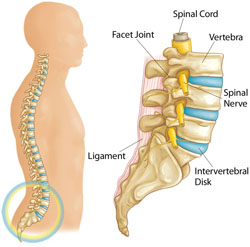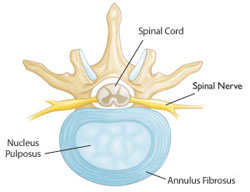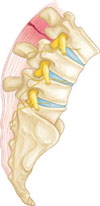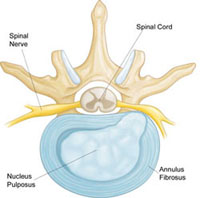Switch to Low Back Pain Treatment in Arlington, VA
Dealing with Pain
Almost everyone will experience low back pain at some point in their lives. This pain can vary from mild to severe. It can be short-lived or long-lasting. However it happens, low back pain can make many everyday activities difficult to do.
Anatomy of your Back
Understanding your spine and how it works can help you understand why you have low back pain. Your spine is made up of small bones, called vertebrae, which are stacked on top of one another. Muscles, ligaments, nerves, and intervertebral discs are all parts that make up your spine.
Vertebrae: These bones connect to create a canal that protects the spinal cord. The spinal column is made up of three sections that create three natural curves in your back: the curves of the neck area (cervical), chest area (thoracic), and lower back (lumbar). The lower section of your spine (sacrum and coccyx) is made up of vertebrae that are fused together. Five lumbar vertebrae connect the upper spine to the pelvis.
Spinal Cord and Nerves: These “electrical cables” travel through the spinal canal carrying messages between your brain and muscles. Nerves branch out from the spinal cord through openings in the vertebrae.
Muscles and Ligaments: These provide support and stability for your spine and upper body. Strong ligaments connect your vertebrae and help keep the spinal column in position.
Facet Joints: Between vertebrae are small joints that help your spine move.
Intervertebral Discs sit in between the vertebrae. When you walk or run, the discs act as shock absorbers and prevent the vertebrae from bumping against one another. They work with your facet joints to help your spine move, twist and bend. Intervertebral discs are flat and round, and about a half-inch thick. They are made up of two components.
Annulus fibrosus. This is the tough, flexible outer ring of the disc. It helps connect to the vertebrae.
Nucleus pulposus. This is the soft, jelly-like center of the annulus fibrosus. It gives the disc its shock-absorbing capabilities.
What Causes Low Back Pain?
Back pain is different from one person to the next. The pain can have a slow onset or come on suddenly. The pain may be intermittent or constant. In most cases, back pain resolves on its own within a few weeks.
There are many causes of low back pain. It sometimes occurs after a specific movement such as lifting or bending. Just getting older also plays a role in many back conditions.
As we age, our spines age with us. Aging causes degenerative changes in the spine. These changes can start in our 30s — or even younger — and can make us prone to back pain, especially if we overdo our activities.
These aging changes, however, do not keep most people from leading productive, and generally, pain-free lives. We have all seen the 70-year-old marathon runner who, without a doubt, has degenerative changes in her back!
Low Back Pain due to Over-activity
One of the more common causes of low back pain is muscle soreness from over-activity. Muscles and ligament fibers can be overstretched or injured. This is often brought about by that first softball or golf game of the season, or too much yard work or snow shoveling in one day. We are all familiar with this “stiffness” and soreness in the low back — and other areas of the body — that usually goes away within a few days.
Disc Injury
Some people develop low back pain that does not go away within days. This may mean there is an injury to a disc.
Disc tear: Small tears to the outer part of the disc (annulus) sometimes occur with aging. Some people with disc tears have no pain at all. Others can have pain that lasts for weeks, months, or even longer. A small number of people may develop constant pain that lasts for years and is quite disabling. Why some people have pain and others do not, is not well understood.
Disc herniation Another common type of disc injury is a “slipped” or herniated disc. A disc herniates when its jelly-like center (nucleus) pushes against its outer ring (annulus). If the disc is very worn or injured, the nucleus may squeeze all the way through. When the herniated disc bulges out toward the spinal canal, it puts pressure on the sensitive spinal nerves, causing pain. Because a herniated disc in the low back often puts pressure on the nerve root leading to the leg and foot, pain often occurs in the buttock and down the leg. This is sciatica. A herniated disc often occurs with lifting, pulling, bending, or twisting movements.
Disc Degeneration
With age, intervertebral discs begin to wear away and shrink. In some cases, they may collapse completely and cause the facet joints in the vertebrae to rub against one another. Pain and stiffness result. This “wear and tear” on the facet joints is referred to as osteoarthritis. It can lead to further back problems, including spinal stenosis.
Degenerative Spondylolisthesis
(Spon-dee-low-lis-THEE-sis). Changes from aging and general wear and tear make it hard for your joints and ligaments to keep your spine in the proper position. The vertebrae move more than they should, and one vertebra can slide forward on top of another. If too much slippage occurs, the bones may begin to press on the spinal nerves.
Spinal Stenosis
Spinal stenosis occurs when the space around the spinal cord narrows and puts pressure on the cord and spinal nerves. When intervertebral discs collapse and osteoarthritis develops, your body may respond by growing new bone in your facet joints to help support the vertebrae. Over time, this bone overgrowth – called spurs – can lead to a narrowing of the spinal canal. Osteoarthritis can also cause the ligaments that connect vertebrae to thicken, which can narrow the spinal canal.
Scoliosis
This is an abnormal curve of the spine that may develop in children, most often during their teenage years. It also may develop in older patients who have arthritis. This spinal deformity may cause back pain and possibly leg symptoms if pressure on the nerves is involved.
Additional Causes
There are other causes of back pain, some of which can be serious. If you have vascular or arterial disease, a history of cancer, or pain that is always there despite your activity level or position, you should consult your primary care doctor.
Low Back Pain Symptoms
Back pain varies. It may be sharp or stabbing. It can be dull, achy, or feel like a “charley horse” type cramp. The type of pain you have will depend on the underlying cause of your back pain. Most people find that reclining or lying down will improve low back pain, no matter the underlying cause.
People with low back pain may experience some of the following:
- Back pain may be worse with bending and lifting.
- Sitting may worsen the pain.
- Standing and walking may worsen pain
- Back pain comes and goes, and often follows an up and down course with good days and bad days.
- Pain may extend from the back into the buttock or outer hip area, but not down the leg.
- Sciatica is common with a herniated disc. This includes buttock and leg pain, and even numbness, tingling, or weakness that goes down to the foot. It is possible to have sciatica without back pain.
Regardless of your age or symptoms, if your back pain does not get better within a few weeks, or is associated with fever, chills, or unexpected weight loss, you should call your doctor. Your best option to find relief in Bethesda, MD can be found at OrthoBethesda. Our doctors are orthopedic surgeons that can help you diagnose and treat all of your symptoms to find relief.
Tests and Diagnosis to Find the Cause of your Pain
Medical History and Physical Examination
After discussing your symptoms and medical history, your doctor will examine your back. This will include looking at your back and pushing on different areas to see if it hurts. Your doctor may have you bend forward, backward, and side to side to look for limitations or pain. Your doctor may measure the nerve function in your legs. This includes checking your reflexes at your knees and ankles, as well as strength testing and sensation testing. This might tell your doctor if the nerves are seriously affected.
Imaging Tests
Other tests that may help your doctor confirm your diagnosis include X-rays. Although they only visualize bones, simple X-rays can help determine if you have the most obvious causes of back pain. It will show broken bones, aging changes, curves, or deformities. X-rays do not show discs, muscles, or nerves.
Magnetic resonance imaging (MRI). This study can create better images of soft tissues, such as muscles, nerves, and spinal discs. Conditions such as a herniated disc or an infection are more visible in an MRI scan.
Computerized axial tomography (CAT) scans. If your doctor suspects a bone problem, he or she may suggest a CAT scan. This study is like a three-dimensional X-ray and focuses on the bones.
Bone scan. A bone scan may be suggested if your doctor needs more information to evaluate your pain and to make sure that the pain is not from a rare problem like cancer or infection.
Bone density test. If osteoporosis is a concern, your doctor may order a bone density test. Osteoporosis weakens bone and makes it more likely to break. Osteoporosis by itself should not cause back pain, but spinal fractures due to osteoporosis can.
Your Treatment Options
In general, treatment for low back pain falls into one of three categories: medications, physical medicine, and surgery.
Nonsurgical Treatment
Medications. Several medications may be used to help relieve your pain.
- Aspirin or acetaminophen can relieve pain with few side effects.
- Non-steroidal anti-inflammatory medicines like ibuprofen and naproxen reduce pain and swelling.
- Narcotic pain medications, such as codeine or morphine, may help.
- Steroids, taken either orally or injected into your spine, deliver a high dose of anti-inflammatory medicine.
Physical Therapies. Low back pain can be disabling. Medications and therapeutic treatments combined often relieve pain enough for you to do all the things you want to do.
- Physical therapy can include passive modalities such as heat, ice, massage, ultrasound, and electrical stimulation. Active therapy consists of stretching, weight lifting, and cardiovascular exercises. Exercising to restore motion and strength to your lower back can be very helpful in relieving pain.
- Braces are often used. The most common brace is a corset-type that can be wrapped around the back and stomach. Braces are not always helpful, but some people report feeling more comfortable and stable while wearing them.
- Chiropractic or manipulation therapy is provided in many different forms. Some patients have relief from low back pain with these treatments.
- Traction is often used, but without scientific evidence for effectiveness.
- Other exercise-based programs, such as Pilates or yoga are helpful for some patients.
Surgical Treatment
Most types of surgeries should only be considered when nonsurgical treatment options have been tried and have failed. It is best to try nonsurgical options for 6 months to a year before considering surgery. In addition, surgery should only be considered if your doctor can pinpoint the source of your pain. Surgery is not always a last resort treatment option “when all else fails.” Some patients are not candidates for surgery, even though they have significant pain and other treatments have not worked. Some types of chronic low back pain simply can not be treated with surgery.
Spinal Fusion. This is essentially a “welding” process. The basic idea is to fuse together the painful vertebrae so that they heal into a single, solid bone. Spinal fusion eliminates motion between vertebral segments. It is an option when motion is the source of pain. For example, your doctor may recommend spinal fusion if you have spinal instability, a bad curvature (scoliosis), or severe degeneration of one or more of your discs. The theory is if the painful spine segments do not move, they should not hurt. The fusion of the vertebrae in the lower back has been performed for decades. A variety of surgical techniques have evolved. In most cases, a bone graft is used to fuse the vertebrae. Screws, rods, or a “cage” are used to keep your spine stable while the bone graft heals.
The surgery can be done through your abdomen, your side, your back, or a combination of these. There is even a procedure that is done through a small opening next to your tailbone. No one procedure has been proven better than another.
The results of spinal fusion for low back pain vary. It can be very effective at eliminating pain, not work at all, and everything in between. Full recovery can take more than a year.
Disc Replacement. This procedure involves removing the disc and replacing it with artificial parts, similar to replacements of the hip or knee. The goal of disc replacement is to allow the spinal segment to keep some flexibility and maintain more normal motion. The surgery is done through your abdomen, usually on the lower two discs of the spine.
Prevention
It may not be possible to always prevent low back pain. We cannot avoid the normal wear and tear on our spines that goes along with aging. But there are things we can do to lessen the impact of low back problems. Having a healthy lifestyle is a good start.
Exercise: Combine aerobic exercise, like walking or swimming, with specific exercises to keep the muscles in your back and abdomen strong and flexible.
Proper Lifting: Be sure to lift heavy items with your legs, not your back. Do not bend over to pick something up. Keep your back straight and bend at your knees.
Weight: Maintain a healthy weight. Being overweight puts added stress on your lower back.
Avoid Smoking: Both the smoke and the nicotine cause your spine to age faster than normal.
Proper Posture: Good posture is important for avoiding future problems. A therapist can teach you how to safely stand, sit, and lift.
Testimonials for Dr. Eric J. Feuchtbaum, Back Specialist for OrthoBethesda
Dr. Eric Feuchtbaum is an amazing Doctor. He is one in a million. Surgically he is very talented, but he also has an amazing bedside manner. He truly cares about his patients and their well being. Dr. Feuchtbaum performed surgery on my neck in January 2000. I was in extreme pain prior to surgery. I have had no pain since I woke up from the anesthesia. The first time I met Dr. Feuchtbaum, he gave me his direct email. He is happy to answer questions and wants you to feel comfortable with any procedure that he does. He was very direct and offered me multiple options. The day after discharge, Dr. Feuchtbaum personally called me at home to check on me. I highly recommend you see Dr. Feuchtbaum at Ortho Bethesda if you have spine issues. – J.M.A.
Call to Schedule an Appointment and to find a Low Back Pain Doctor near Bethesda, MD, today
If you have been suffering from any type of back pain, it is time to schedule an appointment for care with the experienced and trusted team at OrthoBethesda in Bethesda, Maryland. Our staff will diagnose your orthopedic conditions, build a treatment plan for care, and help you through physical therapy. Diagnosis is important when it comes to helping our providers develop the right plan for you. Call us today at (301) 530-1010 to schedule an appointment or for more information. Our patients’ health is always our priority and we take precautions to make our office safe for our patients. We offer both virtual and in-office appointments. In-office appointments are offered Monday through Friday from 8 a.m. – 4:30 p.m. Please call our office (301) 530-1010 and our telephone triage personnel will help determine:
Further Reading
How to Reduce Low Back Pain
How to Prevent Back Pain When Working From Home
 ">
">
Contact OrthoBethesda Today!
Let OrthoBethesda Treat Pain in Your Lower BackFor quality treatment to alleviate low back pain, contact OrthoBethesda! We utilize cutting edge technology to treat your pain correctly. Call us at (301) 530-1010 to make an appointment with us today!







